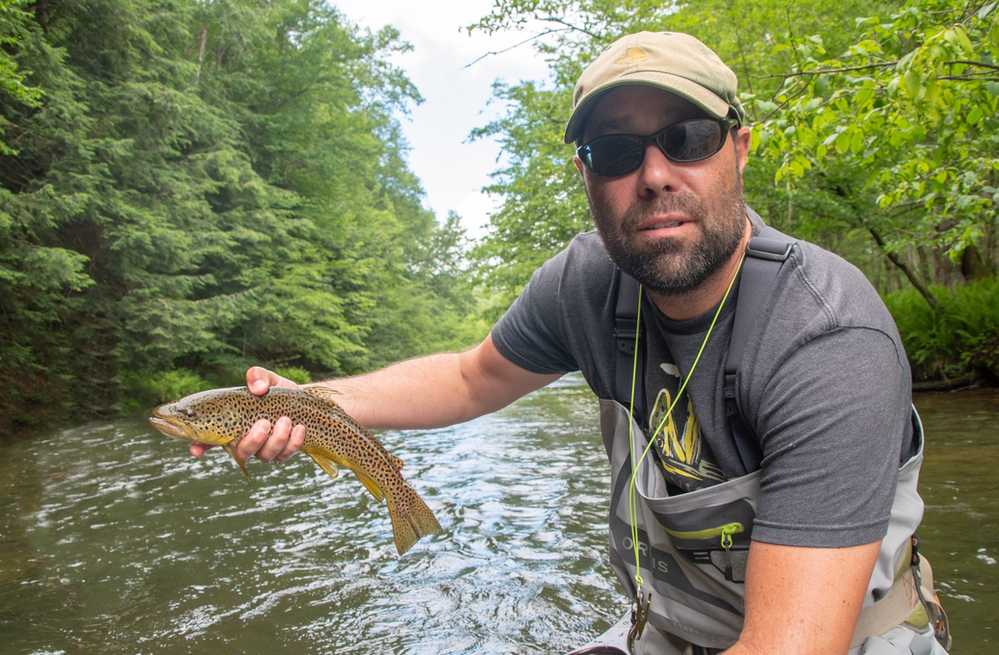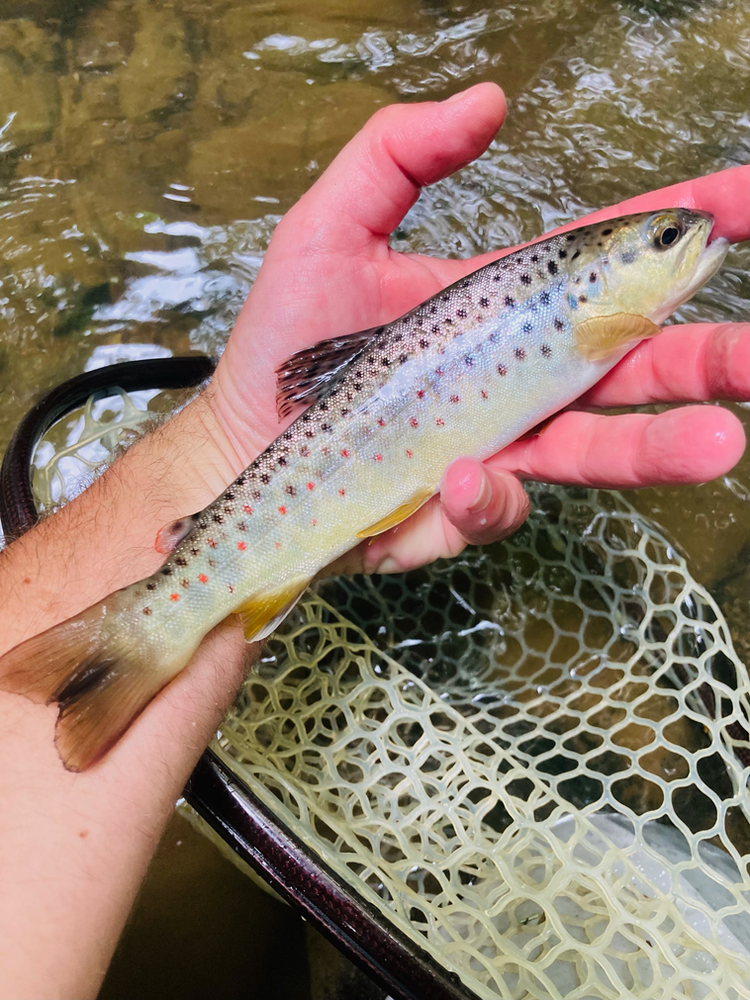Is it a Riffle or Run…and Does it Even Matter? Nymphing Approaches for a Specific Water Type

Fly fishermen, especially nymph fishermen, are obsessed with naming different types of flowing water for discussion purposes. There are glides, slicks, pools, eddies, back channels, junctions, bank water, pocket water, ledges, tailouts, and, of course, riffles and runs. But, more often than not, there is a lot of ambiguity between these different types of trout stream water.
The confusion occurs where the junction becomes an eddy, the glide becomes a pool, the tailout enters pocket water, and the edge water disappears into a back channel. Nonetheless, the greatest gray area of all falls on the differences between riffles and runs because a riffle is no more than a shallow run and a run is simply a deep riffle.
Defining a Riffle and a Run
Riffles and runs are places where a stream or river changes significantly from a higher elevation to a lower one. The water in riffles and runs is moving faster where aquatic life must cling to the bottom where friction is slowing the speed. Riffles are typically shallow and identified by the surface being continuously broken into turbulent, tiny standing waves as water travels over a gravelly and cobbled bottom.
Runs are deeper than riffles so that the surface water is smooth and unbroken. The stream bottom in runs is most often composed of rocks and cobbles, too.
Riffles and runs are where aquatic insect larvae, baitfish, crayfish, and trout fry and fingerlings prefer to live. Riffles and runs are the nursery waters on a healthy stream and river ecosystem, and, as a result, is where mature trout move in to feed.
Accomplished fisherman and outdoor writer, Tom Rosenbauer, defines these water types thoroughly in his book The Orvis Guide to Reading Trout Streams. Rosenbauer explains:
“A run is an area water takes from one elevation to a lower one. Between pools, or when the slope of the land drops for an extended distance, water flows through a channel that might be shallow and carpeted with gravel, through a relatively deep, narrow channel with a quick change in slope, through a flat piece of land like a meadow where the slope of the land changes gradually or through either type of channel with the bottom covered in boulders.”
Pages later, he continues to define, “A riffle is any run that is so shallow that turbulence from the bottom is mirrored on the surface of the water throughout…, resulting in an almost continuous pockmarking of the surface. The depth can be anywhere from an inch to three feet. Any deeper than three feet and the turbulence from the bottom won’t get to the surface so the water will look smooth.”
The Ruffle!
One of the most productive spots on any given trout stream remains that piece of fast-ish flowing water that is just too deep to be a riffle and just too shallow to be a proper run, i.e., the ruffle. This spot likely exists immediately following a legitimate riffle where the stream bottom falls off creating just a bit more depth. This spot in the trout stream is likely 28-36” deep. Finally, on a wild trout stream with a healthy biomass of aquatic life, this spot is guaranteed to be a fish condominium with an all they can eat buffet.
Fishing Approaches and Techniques for Riffles, Er, Ruffles
With technical definitions behind, the question becomes, how can this ruffle be successfully fished? For a point of reference, this article is written from the perspective of a spot I recently fished in northwestern Pennsylvania.
Looking at the top of the riffle, it is visible where the depth changes exist, marked by a difference in water colors and surface features, from about 15-20 inches to 20-28 inches deep. I prefer to wade into position so that this depth change is approximately 15-20 feet upstream. It is also important to be facing upstream at about a forty-five degree angle. Once in this position, the head of the riffle can be fully covered from the near to far sides while making minor adjustments to work through each individual seam. Sometimes taking just one step in any direction to get to a slightly different angle can make all the difference and induce a hookup.
When contact nymphing, I focus on creating short, precise, controlled drifts. Using a 10-foot 3-weight nymphing rod, I try to cast approximately 15-20 feet upstream and 10 feet across. I cover the water one seam at a time and continuously work up and across slightly by changing positions. Casting more leader and attempting longer drifts than this is rarely successful for me because I simply cannot control my tippet and flies. I also shorten my tippet length considerably in riffles to about 42 inches. Realistically, this is all that I am able to feasibly control while maintaining contact in the shallow water.
Preferably, I try to cast up and slightly across stream, sharply stopping my forward stroke and tucking the flies so they enter the water first, up and into the shallows. Guiding the flies through the shallows and into the primary depth change, I lower my rod tip to control the depth I am fishing. I also use my reel hand to pull line in to control the depth I am fishing my flies, taking up slack as they approach me downstream. I try to visualize fishing my flies 2-4 inches off of the bottom keeping them in the feeding lanes of the trout. As the flies come to a point directly across the stream from where I am standing, I pick up, recast and begin my next drift.

Here, Justin demonstrates his preferred approach: facing quartering upstream, casting two rod lengths up and one rod length over and then guiding his flies into the seam he wants to fish.
There are times where I finish the drift downstream of my location, and this does result in some takes and hookups. Of course, trout streams are dynamic, busy, fluid places, and there are times when fishing upstream and slightly across is just not feasible. Adapt to the water available and fish across and downstream if and when necessary. Afterall, trout that are not fished for can simply not be caught. Being flexible and innovative on the water is also necessary to put fish in the net.
Reading the Riffle
Riffles often appear quite uniform on the water’s surface. However, this is largely misleading. Understanding that the stream bottom in a riffle is varied, albeit slight, is the most important component of this water type to recognize and catch fish. Riffle bottoms include nooks and crannies, potholes, channels, a variety of sizes of pebbles and cobbles, branches, limbs and small logs that change the water speed. Seeing and reading these micro-structures are the keys to catching fish in riffles.
If the structure on the bottom cannot be seen, noticing irregularities in the way the surface water looks often indicates submerged objects. Nymphs can also be used to “see” the structure on the bottom of the stream and help anglers guide their subsurface offerings to the best holding lies. When fishing a seam, remember where the nymphs tick off of a higher rock on the stream bottom or snag on a sunken tree limb. These structures create friction which slows the water and becomes places trout will hold to feed.

Seams deliver food to trout, which is why fish will stack up here. It’s the easiest way to catch prey while expending the least amount of energy.
Back to the Riffle Approach and Fishing Technique
Again, consider that northwestern PA riffle referenced previously. Viewing this piece of water, three distinct bottom color changes were visible. Reading each of these seam structures exhibits holding lies for trout.
On the near, left side, looking upstream, the bottom is a light tan. This is evidence that the riffle bottom is sand. Reading this communicates to the angler that the water speed is considerably slower in this seam because the sand is deposited and not rinsed away by faster currents. The water depth here is only 12-15 inches deep.
In the middle of the riffle, the bottom is a darker black and maybe 25-28 inches at its deepest. This suggests a clean, cobbled stream bottom as the fastest water acts as a scouring pad.
Finally, the third visible structure nearest the far bank is a dark olive-brown, likely about 20 inches deep and composed of algae and moss covered rocks. This section of the riffle exhibits yet another water speed change.
Each of these bottom color changes possess a distinct seam to be fished. And fish will hold along the line of each color change because this is where the food is delivered. Think of the fastest seam as a freight train delivering the food. This fast seam is the food service delivery vehicle. The slower, sandy bottom seam is where the food, like the shelving in a grocery store, is deposited, waiting to be selected by trout. The far spot, the deli counter to sit down and have a sandwich, is where the fish move in and out to eat their prey as it slowly drifts by.
My approach is to cast upstream of each of these riffle seams and guide my flies directly into the color-change lines. Once my flies are in the targeted seam, I stop guiding and establish a dead drift. It is crucial to keep the flies and tippet all in a single seam so that varied currents do not pull things in different directions creating drag. This might be the contact nymphing skill that requires the most practice! This skill took me four years of practicing to develop proficiency and I am still far from mastery.
Moreover, I recognize that my flies and tippet are in a single current seam by sight and never feel. This is observable when the sighter is moving at a slower speed than the top of the water. I know that my flies are dead-drifting in a single seam and traveling at the same slower speed as the water on the riffle bottom. Get ready to set the hook because achieving this objective is the exact moment when trout will take your offerings!
At first glance, riffles appear to be uniform and boring, void of aquatic life. However, upon closer inspection, these sections potentially hold the largest concentrations of trout. Targeting riffles specifically during fishing sessions may just create more takes, hookups and landed trout in the net.
_____
Learn more about fishing riffles and runs in this video: Reading the Water: Color Changes and Seams.”
Did You Enjoy This Post From Justin?
Stay up to date with the Dark Skies Fly Fishing monthly newsletter for free and receive the latest fly fishing news, tricks, tips, and techniques, stream reports, as well as updates on new flies added to the Online Store and exclusive discounts!
Sign Up Now